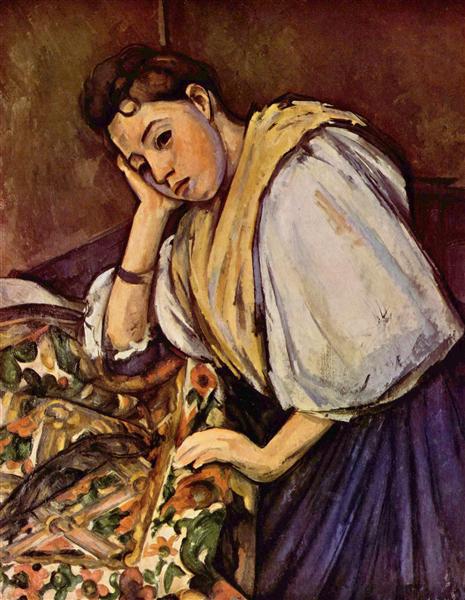Beskrivelse
Paul Cézanne's Young Italian Woman Leaning on Her Elbow, created in 1896, is a clear example of the artist's singular approach to the depiction of the human body and the exploration of form. In this painting, Cézanne depicts a young woman reclining on her elbow, her posture suggesting a mix of intimacy and contemplation. The simplicity of the background highlights the figure, but also reflects the emotional depth and complexity that characterizes the Post-Impressionist master's work.
Looking at the composition, it is clear that Cézanne has chosen an arrangement that allows the viewer's eyes to follow the angle of the young woman's body. The diagonal line formed by her arm and the inclination of her torso invites the viewer to enter the space occupied by the figure. The girl's head, turned to her left side, suggests a moment of rest, almost of absorption, creating a visual narrative that encapsulates both the fragility and the strength of youth.
The use of colour in this work is particularly notable. Cézanne applies his signature modulated brushstrokes, which lend a rich and complex texture to the young woman's skin. The skin tones are warm, with a slight yellowish tint that reflects the light naturally and almost sketches the vitality of youth. At the same time, the palette used in the background, with its soft shadows and earthy tones, contrasts with the luminosity of the face, immediately drawing attention to the central figure. This contrast of colours is a testament to Cézanne's ability to play with light and form, an integral element of his style.
Cézanne is known for his exploration of visual perception and reality, and Young Italian Woman Leaning on Her Elbow is no exception. Although the central figure is rendered with exceptional care, Cézanne does not stop there. In long study, the artist breaks down and reconfigures the form, capturing the essence of youth through geometry and simplification. This decomposition is a recurring theme in his work and positions him as a precursor to Cubism.
The historical context of this work is also fascinating. In the 1890s, Cézanne was moving away from pure impressionist representation, seeking to integrate more structure into his compositions. This transition allowed him to explore themes that were previously considered conventional, challenging the conventions of the art of his time. Through this painting, we glimpse the artist's internal struggle between depicting the outside world and creating his own visual reality.
The figure of the lonely young woman could not only be interpreted as a symbol of Italian youth at the time, but is also a reflection of Cézanne's own process, which allowed him to explore both his identity and his place in the art world. The association between portraiture and personal introspection is a testament to the profound complexity of the work, an aspect that art critics have debated over the decades.
In short, Paul Cézanne's "Young Italian Woman Leaning on Her Elbow" is not just a work of art; it is a visual dialogue between the artist and his model, the viewer and the object being observed. Through his mastery of color, form, and light, Cézanne manages to capture an ephemeral moment filled with meaning, establishing moments of connection between the personal and the universal, the intangible and the visually tangible. The relevance of this painting endures, not only as a milestone in Cézanne's career, but as a crucial piece in the development of modern art.
KUADROS ©, a famous painting on your wall.
Hand-made oil painting reproductions, with the quality of professional artists and the distinctive seal of KUADROS ©.
Painting reproduction service with satisfaction guarantee. If you are not completely satisfied with the replica of your painting, we will refund 100% of your money.

